battery CHEVROLET DURAMAX 2006 Owners Manual
[x] Cancel search | Manufacturer: CHEVROLET, Model Year: 2006, Model line: DURAMAX, Model: CHEVROLET DURAMAX 2006Pages: 100, PDF Size: 0.71 MB
Page 4 of 100
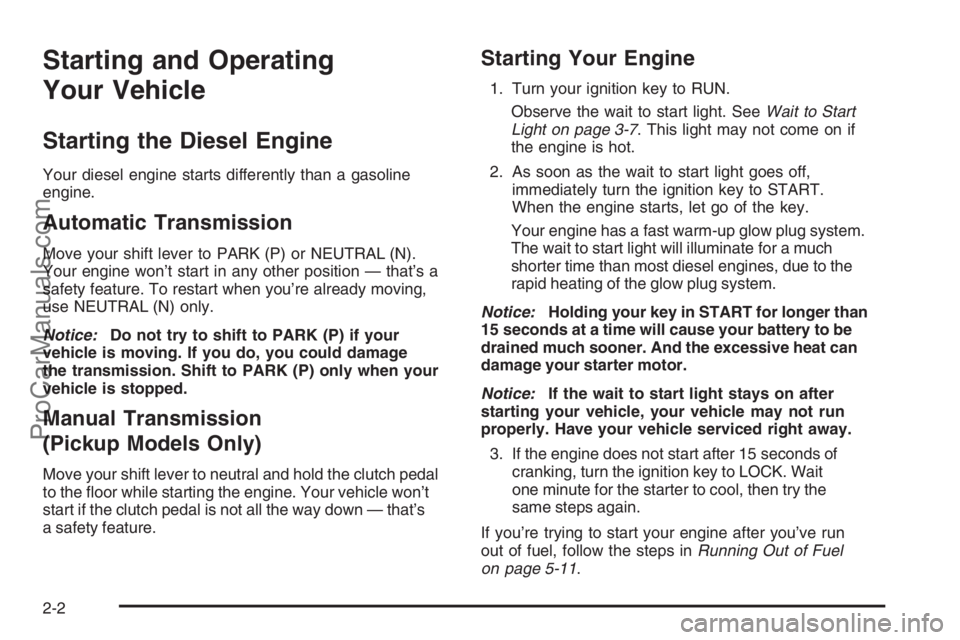
Starting and Operating
Your Vehicle
Starting the Diesel Engine
Your diesel engine starts differently than a gasoline
engine.
Automatic Transmission
Move your shift lever to PARK (P) or NEUTRAL (N).
Your engine won’t start in any other position — that’s a
safety feature. To restart when you’re already moving,
use NEUTRAL (N) only.
Notice:Do not try to shift to PARK (P) if your
vehicle is moving. If you do, you could damage
the transmission. Shift to PARK (P) only when your
vehicle is stopped.
Manual Transmission
(Pickup Models Only)
Move your shift lever to neutral and hold the clutch pedal
to the floor while starting the engine. Your vehicle won’t
start if the clutch pedal is not all the way down — that’s
a safety feature.
Starting Your Engine
1. Turn your ignition key to RUN.
Observe the wait to start light. SeeWait to Start
Light on page 3-7. This light may not come on if
the engine is hot.
2. As soon as the wait to start light goes off,
immediately turn the ignition key to START.
When the engine starts, let go of the key.
Your engine has a fast warm-up glow plug system.
The wait to start light will illuminate for a much
shorter time than most diesel engines, due to the
rapid heating of the glow plug system.
Notice:Holding your key in START for longer than
15 seconds at a time will cause your battery to be
drained much sooner. And the excessive heat can
damage your starter motor.
Notice:If the wait to start light stays on after
starting your vehicle, your vehicle may not run
properly. Have your vehicle serviced right away.
3. If the engine does not start after 15 seconds of
cranking, turn the ignition key to LOCK. Wait
one minute for the starter to cool, then try the
same steps again.
If you’re trying to start your engine after you’ve run
out of fuel, follow the steps inRunning Out of Fuel
on page 5-11.
2-2
ProCarManuals.com
Page 5 of 100
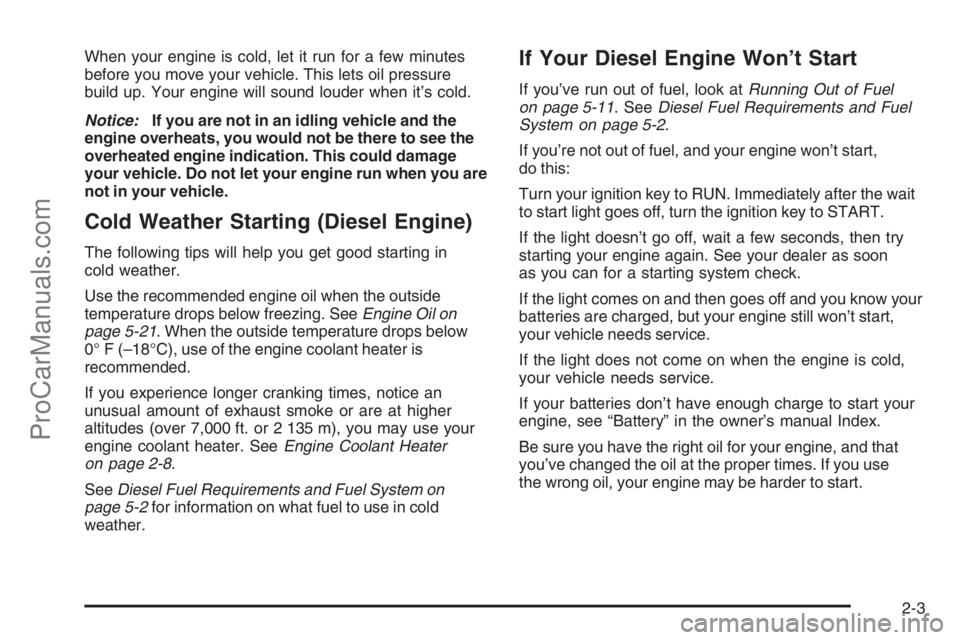
When your engine is cold, let it run for a few minutes
before you move your vehicle. This lets oil pressure
build up. Your engine will sound louder when it’s cold.
Notice:If you are not in an idling vehicle and the
engine overheats, you would not be there to see the
overheated engine indication. This could damage
your vehicle. Do not let your engine run when you are
not in your vehicle.
Cold Weather Starting (Diesel Engine)
The following tips will help you get good starting in
cold weather.
Use the recommended engine oil when the outside
temperature drops below freezing. SeeEngine Oil on
page 5-21. When the outside temperature drops below
0° F (–18°C), use of the engine coolant heater is
recommended.
If you experience longer cranking times, notice an
unusual amount of exhaust smoke or are at higher
altitudes (over 7,000 ft. or 2 135 m), you may use your
engine coolant heater. SeeEngine Coolant Heater
on page 2-8.
SeeDiesel Fuel Requirements and Fuel System on
page 5-2for information on what fuel to use in cold
weather.
If Your Diesel Engine Won’t Start
If you’ve run out of fuel, look atRunning Out of Fuel
on page 5-11. SeeDiesel Fuel Requirements and Fuel
System on page 5-2.
If you’re not out of fuel, and your engine won’t start,
do this:
Turn your ignition key to RUN. Immediately after the wait
to start light goes off, turn the ignition key to START.
If the light doesn’t go off, wait a few seconds, then try
starting your engine again. See your dealer as soon
as you can for a starting system check.
If the light comes on and then goes off and you know your
batteries are charged, but your engine still won’t start,
your vehicle needs service.
If the light does not come on when the engine is cold,
your vehicle needs service.
If your batteries don’t have enough charge to start your
engine, see “Battery” in the owner’s manual Index.
Be sure you have the right oil for your engine, and that
you’ve changed the oil at the proper times. If you use
the wrong oil, your engine may be harder to start.
2-3
ProCarManuals.com
Page 17 of 100
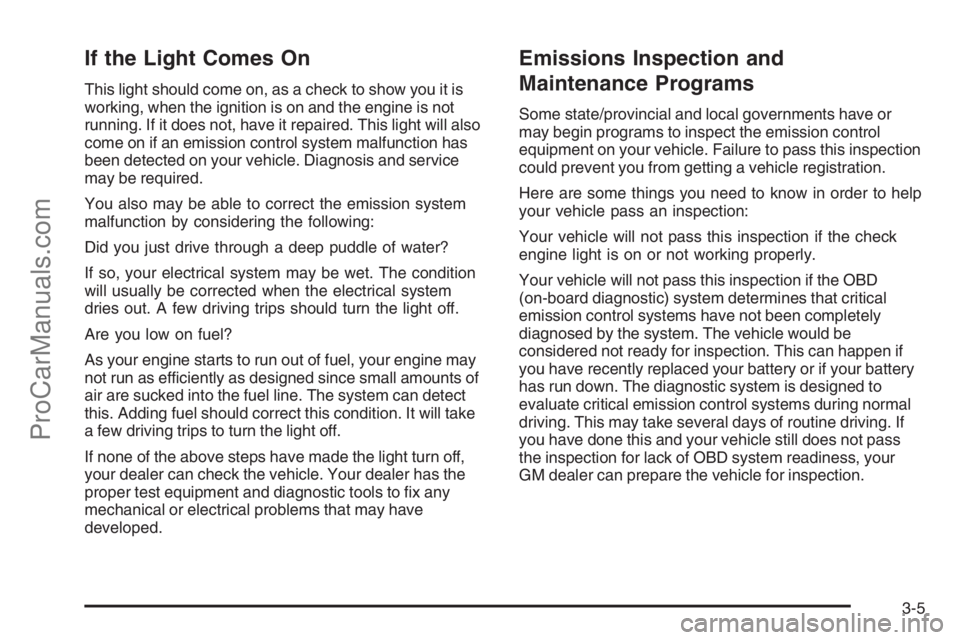
If the Light Comes On
This light should come on, as a check to show you it is
working, when the ignition is on and the engine is not
running. If it does not, have it repaired. This light will also
come on if an emission control system malfunction has
been detected on your vehicle. Diagnosis and service
may be required.
You also may be able to correct the emission system
malfunction by considering the following:
Did you just drive through a deep puddle of water?
If so, your electrical system may be wet. The condition
will usually be corrected when the electrical system
dries out. A few driving trips should turn the light off.
Are you low on fuel?
As your engine starts to run out of fuel, your engine may
not run as efficiently as designed since small amounts of
air are sucked into the fuel line. The system can detect
this. Adding fuel should correct this condition. It will take
a few driving trips to turn the light off.
If none of the above steps have made the light turn off,
your dealer can check the vehicle. Your dealer has the
proper test equipment and diagnostic tools to fix any
mechanical or electrical problems that may have
developed.
Emissions Inspection and
Maintenance Programs
Some state/provincial and local governments have or
may begin programs to inspect the emission control
equipment on your vehicle. Failure to pass this inspection
could prevent you from getting a vehicle registration.
Here are some things you need to know in order to help
your vehicle pass an inspection:
Your vehicle will not pass this inspection if the check
engine light is on or not working properly.
Your vehicle will not pass this inspection if the OBD
(on-board diagnostic) system determines that critical
emission control systems have not been completely
diagnosed by the system. The vehicle would be
considered not ready for inspection. This can happen if
you have recently replaced your battery or if your battery
has run down. The diagnostic system is designed to
evaluate critical emission control systems during normal
driving. This may take several days of routine driving. If
you have done this and your vehicle still does not pass
the inspection for lack of OBD system readiness, your
GM dealer can prepare the vehicle for inspection.
3-5
ProCarManuals.com
Page 43 of 100
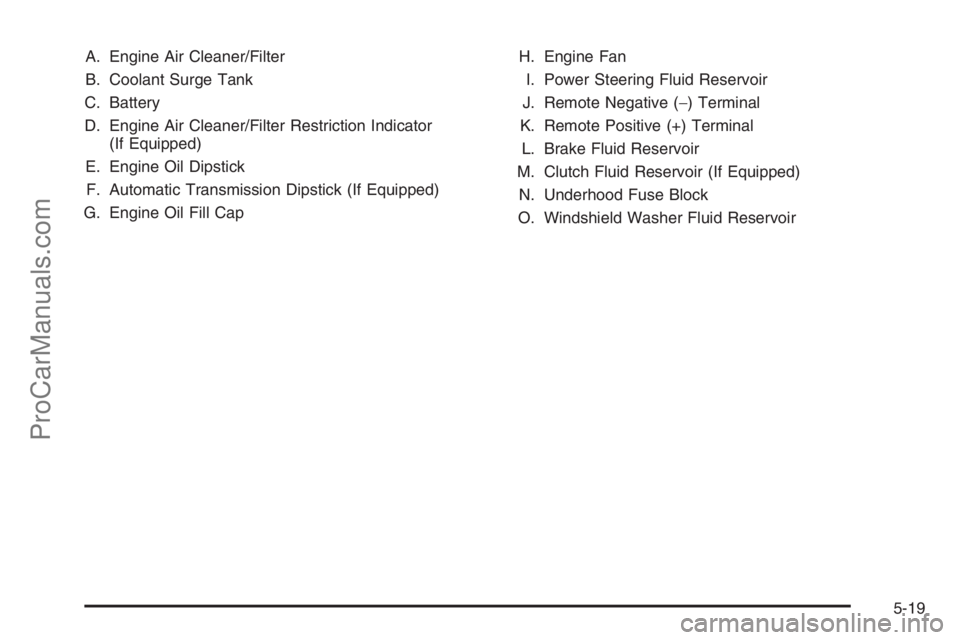
A. Engine Air Cleaner/Filter
B. Coolant Surge Tank
C. Battery
D. Engine Air Cleaner/Filter Restriction Indicator
(If Equipped)
E. Engine Oil Dipstick
F. Automatic Transmission Dipstick (If Equipped)
G. Engine Oil Fill CapH. Engine Fan
I. Power Steering Fluid Reservoir
J. Remote Negative (−) Terminal
K. Remote Positive (+) Terminal
L. Brake Fluid Reservoir
M. Clutch Fluid Reservoir (If Equipped)
N. Underhood Fuse Block
O. Windshield Washer Fluid Reservoir
5-19
ProCarManuals.com
Page 45 of 100
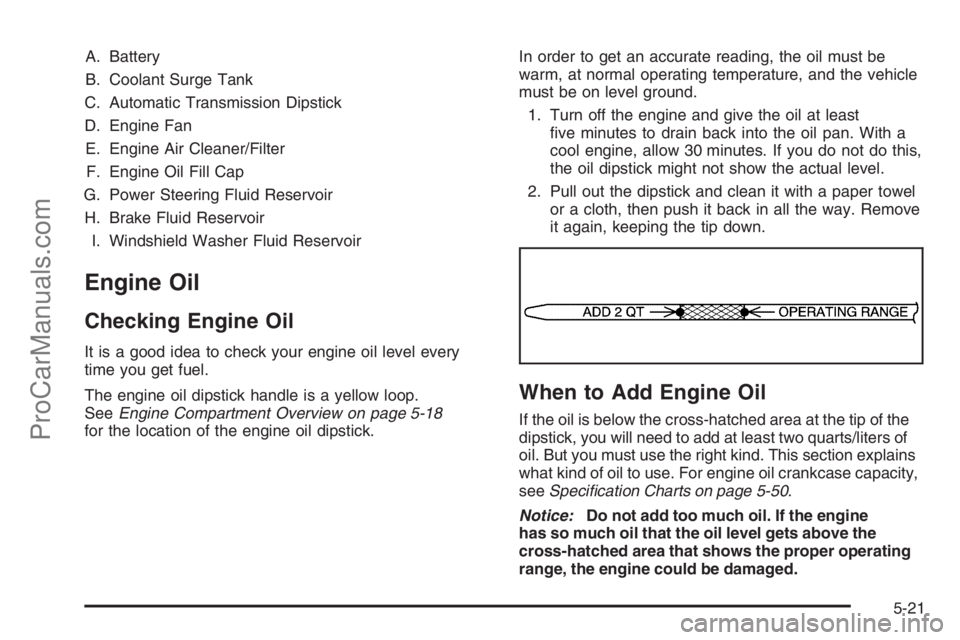
A. Battery
B. Coolant Surge Tank
C. Automatic Transmission Dipstick
D. Engine Fan
E. Engine Air Cleaner/Filter
F. Engine Oil Fill Cap
G. Power Steering Fluid Reservoir
H. Brake Fluid Reservoir
I. Windshield Washer Fluid Reservoir
Engine Oil
Checking Engine Oil
It is a good idea to check your engine oil level every
time you get fuel.
The engine oil dipstick handle is a yellow loop.
SeeEngine Compartment Overview on page 5-18
for the location of the engine oil dipstick.In order to get an accurate reading, the oil must be
warm, at normal operating temperature, and the vehicle
must be on level ground.
1. Turn off the engine and give the oil at least
five minutes to drain back into the oil pan. With a
cool engine, allow 30 minutes. If you do not do this,
the oil dipstick might not show the actual level.
2. Pull out the dipstick and clean it with a paper towel
or a cloth, then push it back in all the way. Remove
it again, keeping the tip down.
When to Add Engine Oil
If the oil is below the cross-hatched area at the tip of the
dipstick, you will need to add at least two quarts/liters of
oil. But you must use the right kind. This section explains
what kind of oil to use. For engine oil crankcase capacity,
seeSpeci�cation Charts on page 5-50.
Notice:Do not add too much oil. If the engine
has so much oil that the oil level gets above the
cross-hatched area that shows the proper operating
range, the engine could be damaged.
5-21
ProCarManuals.com